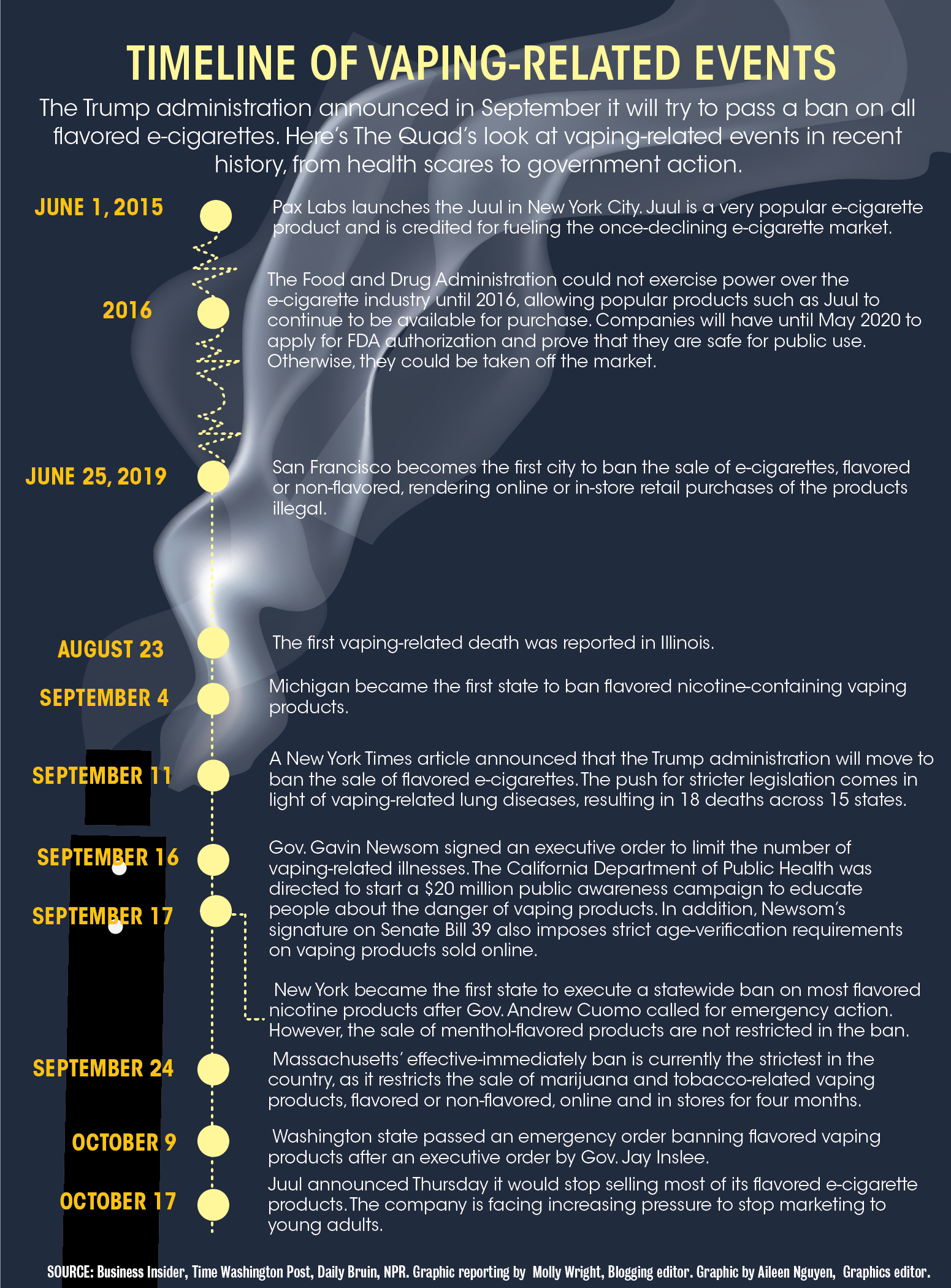The Quad: Understanding the history and future of e-cigarettes amid growing regulations


By Karen Im
Oct. 22, 2019 5:16 p.m.
Mango, creme brulee and fruit medley: The range of electronic cigarette flavors sounds undeniably delectable – perhaps to the point of concern.
The city of Los Angeles could ban all e-cigarettes and vaping devices until they are deemed safe by the federal Food and Drug Administration, as proposed at a city council meeting Oct. 8.
If the law passes, Los Angeles would be following the footsteps of San Francisco as well as a number of states, such as Massachusetts and Washington, in instituting an emergency ban on flavored vaping products.
Touted as a “safer alternative” to traditional tobacco cigarettes, e-cigarettes hit the U.S. market a decade ago. In recent weeks, there have been an influx of reports of hospitalizations and deaths due to severe vape-related lung illnesses, putting e-cigarette producers, like Juul Labs, squarely in the sights of the government.
The History
Within a year of its launch in 2015, Juul sales skyrocketed to capture nearly one-third of the e-cigarette market. Overtime, Juul and other e-cigarettes brands have entered the spotlight due to the newly emerging public health crisis, as their success is correlated with a surge in vaping among teens and young adults.
Juul is famously marketed under its mission to “improve the lives of the world’s one billion adult smokers by eliminating cigarettes,” but analyses of Juul’s marketing techniques have incited doubt over its intended target market, which seems to be a much younger crowd.
Many speculate that Juul’s e-cigarette flavors, which range from mint and mango to creme brulee and tobacco, are targeted toward youth as opposed to adults trying to quit. This speculation may explain the coinciding of Juul’s market explosion with the surge of teenage vaping.
According to a January 2019 study by the National Institute on Drug Abuse, 30% of the nation’s 12th grade students in 2018 reported vaping nicotine at least once in the past year. The study deemed this to be the largest percentage for any substance in the past 44 years.
Burt Cowgill, an adjunct assistant professor in the department of health policy and management at the UCLA Fielding School of Public Health, classifies youth vaping as an epidemic due to the dramatic increase in usage of e-cigarette products in this particular population over the past decade.
“Our nation has seen traditional cigarette smoking decline for a number of years and rates are at their all-time low,” Cowgill said. “E-cigarettes got introduced into the U.S. around ten years ago, and we’ve seen the most dramatic increase in usage amongst high school students and young adults – populations in which we’ve seen very little traditional tobacco usage with.”
The Impact
These rampant proportions are just now starting to bare their ugly teeth.
As of Oct. 8, the Centers for Disease Control and Prevention reported 1,299 cases of e-cigarette-related lung injuries in 49 states and 26 subsequent deaths across 21 different states, and the number is growing.
The illness – recently named e-cigarette or vaping product use-associated lung injury by the CDC – is suspected to be most commonly associated with vape products containing THC, a psychoactive ingredient in marijuana. These products are often found on the black market, and can contain a dangerous mixture of toxins and chemicals that may be detrimental to the lungs.
Legislation
For the past decade, the federal government has repeatedly delayed the regulation of e-cigarettes. In the face of a federal regulatory absence and recent health complications, state and local governments have stepped in and imposed their own bans and restrictions.
San Francisco was the first major U.S. city to ban the sale and distribution of e-cigarettes on June 25 in an attempt to combat youth nicotine addiction.
Many states across the United States have taken similar measures against widespread teenage vaping since San Francisco’s initial decision.
New York state health officials voted to ban sales of most flavored e-cigarettes on Sept. 17 in response to data showing that New York high school student use of tobacco products rose 160% from 2014 to 2018. This piece of emergency legislation stands for 90 days until potential renewal.
Los Angeles may be the next city to act. The city of Los Angeles recently established a proposal to ban all e-cigarettes and vaping devices under a motion introduced by Councilmember Paul Koretz on Oct. 8.
The proposal was referred to a health committee to be carefully analyzed before deciding whether to submit it to the full council for a vote. If passed, city lawyers will draft an ordinance for approval by the council.
Predating this proposal was the unanimous decision made by Los Angeles County officials on Oct. 1 to ban flavored tobacco products, including menthol. This ban will apply to the unincorporated areas of the county at the end of the month.
The Consequences
However, much like any other drastic proposition, there are ramifications that push back against the positives, said Cowgill.
Many vape store owners fear for the survival of their businesses under the severity of state actions banning the sale of e-cigarettes, which arguably make up a majority of their sales.
Additionally, there is concern that making these products illegal will force young people to turn to the internet and the black market.
“With such a polarizing decision, there is the risk that by acting the way that we are, we could be creating new problems in this area,” Cowgill said.
In the heat of a series of legislative imperatives across the nation, we are still grappling to understand what lies ahead for e-cigarettes and vape products in the U.S.
Awareness in Society
The future of vaping in American society will most likely focus itself around two things: awareness and understanding of the unknown.
“In the past, in middle school or high school you would have an anti-smoking assembly or class and you would go home and hear from your parents about how bad cigarettes were for you,” Cowgill said. “So you had a society that was aware of the harms of cigarette smoking and for those that smoked, they accepted those risks.”
Because there is so little concrete research on e-cigarettes, parents, administrators, teachers and mentors of today’s youth are just as in the dark about these products and their potential health effects as kids are.
“As a society, it will become our responsibility to gain a better sense of what we are dealing with in order to make more informed and engaged decisions for our future,” Cowgill said.


